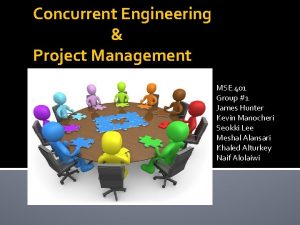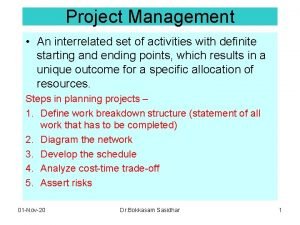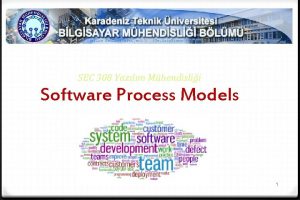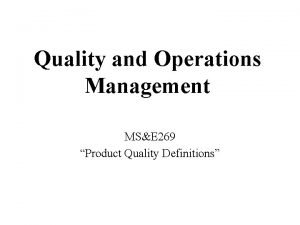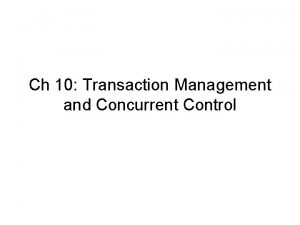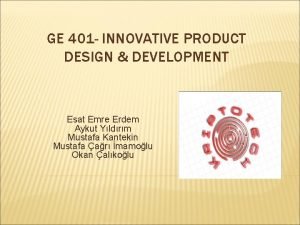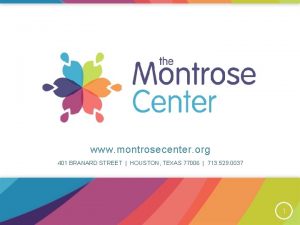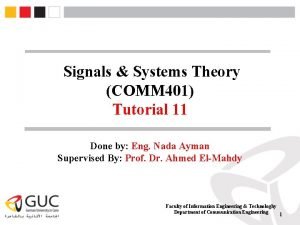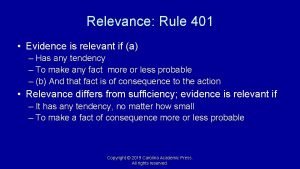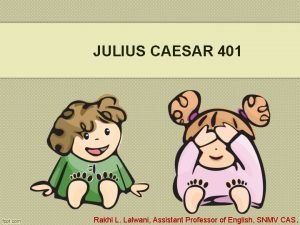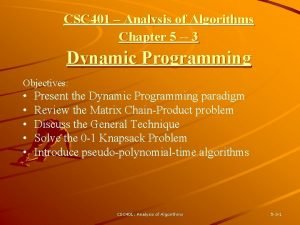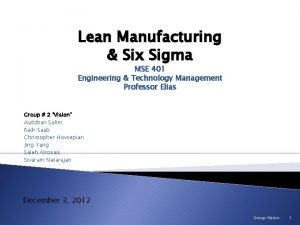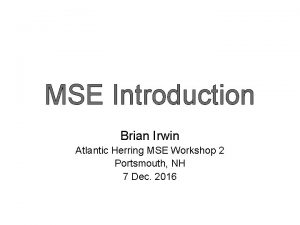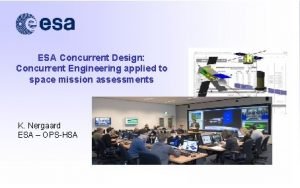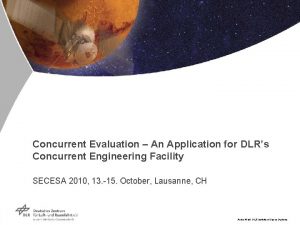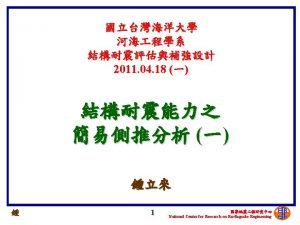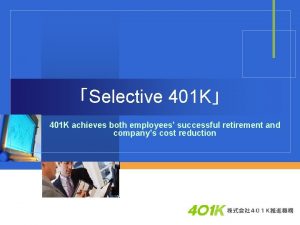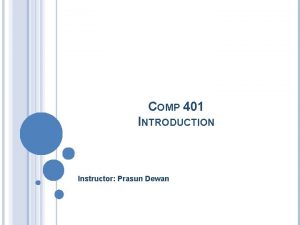Concurrent Engineering Project Management MSE 401 Group 1































- Slides: 31

Concurrent Engineering & Project Management MSE 401 Group #1 James Hunter Kevin Manocheri Seokki Lee Meshal Alansari Khaled Alturkey Naif Alolaiwi

Presentation Outline: � What is Concurrent Engineering � What is Project Management � Wal. Mart's Implementation of CE � Boeing � Conclusion James Hunter

What is Concurrent Engineering: � Concurrent Engineering (CE) is a systematic approach to integrated product development that emphasizes the response to customer expectations. It embodies team values of co-operation, trust and sharing in such a manner that decision making is by consensus, involving all perspectives in parallel, from the beginning of the product life cycle. (http: //en. wikipedia. org/wiki/Concurrent_Engineering) James Hunter

What is Concurrent Engineering: � CE is also known as Simultaneous Engineering or Integrated Product Development � CE is relatively new (Last 25 years) Institute for Defense Analysis (IDA) � Replaces tradition “Waterfall” method � CE was designed to for the Product Development Stage Optimizes engineering design cycles � CE is a long term Strategy � Any successful organization, now, must implement Concurrent Engineering. � Most apparent in the Aerospace Industry James Hunter

What is Concurrent Engineering: Advantaged and Disadvantages: � Advantages : Integrated Project Management (IPM) Integrated Project Teams (IPT) Optimizes Engineering Design Cycles Information Sharing Reduces Costs (Long Term) Maximized Quality (200%-600%) Reduces Development Time (30%- � Disadvantages/Challenges Large Upfront Investment Implementation of Early Design Reviews Dependency on Efficient Communication Software Compatibility Need for Computer Modeling Organizational and Cultural Changes (Anchor draggers) 70%) Reduces Design Rework (65%-90%) James Hunter

What is Project Management: � Project management is the discipline of planning, organizing, securing, managing, leading, and controlling resources to achieve specific goals. � A project is a temporary endeavor with a defined beginning and end (usually time-constrained, and often constrained by funding or deliverables), undertaken to meet unique goals and objectives, typically to bring about beneficial change or added value. Kevin Manocheri

Project Management Overview: � In 1950’s Project management initiated on the construction and defense project when there was more need for it. � Henry Gantt and Henri Fayol are known as the fathers of project management. Gantt for creating scheduling and Fayol for introducing the 5 concepts of managerial functions. � Project management is a technique to control the time, cost, quality and overall scope of the project. � Key metrics of project management are time cost, performance objective. � Project management’s most usable tools are Gantt chart, PERT, (program, evaluation review technique), CPM (critical path method), risk Management, and network Diagram. Kevin Manocheri

Tools Used for PM and CE: � Work Breakdown Structure (WBS) � Organization Assessment IOM Check List � � CPM/PERT Gantt Chart Kevin Manocheri

What is Project Management: Advantaged & Disadvantages: � Advantages : Better efficiency in delivering services Improved and enhanced customer satisfaction Improved growth and development within the team Greater competitive edge Better flexibility Increased risk assessment Provides a plan to follow � Disadvantage: If it’s implemented correctly there is no disadvantage. Kevin Manocheri

Concurrent Engineering & Project Management Relation. �With out descent project management concurrent engineering would not be applicable. �Project Management is a Derivative of CE. �Need PM to implement CE successfully. Kevin Manocheri

Case Study 1: Wal. Mart �Founded year : 1962 �Founder : Sam Walton �World`s third largest corporation by Fortune 500 �Largest retailer in the world �Over 2 million employees �Success in most countries �Unsuccessful in South Korea Seokki Lee

Case Study 1: Wal. Mart Arrival in South Korea : July, 1998 16 stores in South Korea (only 1 in Seoul) Loss in 2005 : $ 10 million Sold all 16 stores to largest local retailer (Shinsegae) Withdrawing business : May, 2006 Seokki Lee

Case Study 1: Walmart Major cause of failure Criteria for failure of CE Uniqueness of Korean consumers Unidentified major mission at the beginning, Ineffective communication with customers EDLP (Everyday Low Price) strategy Insufficient resources for planning, Unidentified external customers Indifferent products Not evolving requirements of customers, Work inflexible with customers Lack of accessibility / Insufficient stores Unmodified tasks to optimize the project output, Lack of communication channels E-commerce (Online shopping) Un-established techniques and protocols for customers (Walmart) (E-mart) Seokki Lee

Boeing Company Case Study James Hunter

Successful CE Case Study Overview �NPD project was executed using the CE implementations: ▪ Boeing’s 777 project Meshal Alansari

Successful Case Study Overview Boeing Commercial Aircraft Division 777 Project: � New technologies: ▪ digital avionics ▪ advanced lightweight materials ▪ dual-engine ▪ two pilot design (%25 less cost per seat-mile) ▪ replacement for 747 family � $4 -5 billion to launch first member of 777 family Meshal Alansari

Successful Case Study Overview � Teams provide the primary integration mechanism in CE projects. � Three types of teams appeared in the project: ▪ Program management team ▪ Technical team ▪ Numerous design-build team Meshal Alansari

Communication Among Teams � Communicating methods included: Face to face communication Phone conversation Document Electronic mail � Based on the project focus, a certain way of communication used: ▪ Project focusing on design quality relied on formal personation and periodic review meetings ▪ Project emphasizing development speed required frequent informal communication Meshal Alansari

Case Study Methodology The selected firm included in the study: 1. Had substantial experience in NPD 2. Were developing relatively complex products 3. Used concurrent engineering methods 4. Operated in highly competitive markets 5. Collectively represented a diversity of product and market needs Meshal Alansari

Case Study Methodology The study used a questionnaire containing 29 open-ended questions addressed: 1. Motivations, risks, and competitive pressures surrounding the project 2. Product complexity and technologies 3. Project scheduling and concurrency 4. Team personnel, organization, incentives, and authority; 5. Definitions, motivations, and benefits of CE 6. Functional interactions and communication modes; 7. Methods and tools used to promote CE 8. Barriers and keys to success Naif Alolaiwi

Challenges in NPD Projects I. Program Priorities: ▪ Design Quality ▪ Product Cost ▪ Product Introduction speed II. Project Characteristics: ▪ Project Complexity ▪ Innovation ▪ Technical Risk Naif Alolaiwi

Program Priorities Design Quality � 777 project: ▪ Has 500 suppliers ▪ Need 3, 000 parts ▪ Has 1700 computer workstation (220 of them in Japan) ▪ New aircraft must prove reliability with at least 2 years to be FAA approved Naif Alolaiwi

Program Priorities Product Cost � Boeing faced significant product cost challenges on the 777 project due to stiff competition from Airbus and the deregulation of the airline industry. Naif Alolaiwi

Project Characteristics Project Complexity � 777 project: ▪ 7000 people located in countries throughout the world ▪ Boeing placed tremendous emphasis on communication to minimize risks Khaled Alturkey

Benefits CE Implementation � Some of the companies documented savings in overall product development costs of approximately 20% and reductions in engineering design changes of 4. 5%-50%. Khaled Alturkey

Summary of CE Practices �At least 3 opportunities exist for concurrent processing: ▪ Simultaneously developing market concept, product designs, manufacturing process, product structures ▪ Overlapping design disciplines so that system level and component level designs are produced concurrently ▪ Overlapping of separate but related new products requiring coordination between NPD programs Khaled Alturkey

Summary of CE Practices � As degrees of overlap among activities become more intense, decisions that are dependent on information from upstream processes become more uncertain (more risk) � Successful CE implementation approaches differ depending on factors such as: ▪ Product characteristics ▪ Customer needs ▪ Technology requirements Khaled Alturkey

Summary of CE Practices � Teams are essential organizational forms for promoting integration � Team arrangements include: program management team, technical team, design-build teams, integration teams, and task forces � The modes, frequency, richness, and formality of communications among project participants varies according to information complexity, design, and timing challenges Khaled Alturkey

Conclusion: � Project Management is needed to implement Concurrent Engineering correctly. � Need Concurrent Engineering to be competitive today. � Project Management is a part of Concurrent Engineering � Generally benefits are greater than the disadvantages James Hunter

Questions & Answers

 Concurrent engineering advantages and disadvantages
Concurrent engineering advantages and disadvantages Concurrent activity in network diagram
Concurrent activity in network diagram Sec 308
Sec 308 Introduction to software project management
Introduction to software project management Mse in operations management
Mse in operations management Concurrent control management
Concurrent control management Lsp401
Lsp401 Svartpilen 401 dyno
Svartpilen 401 dyno Cse401
Cse401 Ge 401
Ge 401 Where should charts with food code 3-401 be displayed
Where should charts with food code 3-401 be displayed Eng m 401
Eng m 401 Clase 401
Clase 401 401 branard street houston tx
401 branard street houston tx Bmb 401 umiami
Bmb 401 umiami Comm 401
Comm 401 401 relevance
401 relevance As riquezas mundanas nada valem pra mim
As riquezas mundanas nada valem pra mim Hd-wp-4k-401-c
Hd-wp-4k-401-c Quantas prendas a turma 403 já levou para a escola
Quantas prendas a turma 403 já levou para a escola Class 600 stitch
Class 600 stitch Program 401 ploiesti
Program 401 ploiesti Herpesviridae
Herpesviridae Multithread chain stitch
Multithread chain stitch Jul 401 english
Jul 401 english Ir 401
Ir 401 Melinex pet
Melinex pet P-401 faa
P-401 faa Csc 401
Csc 401 Ce 401
Ce 401 Ce-401
Ce-401 Rose shawlee
Rose shawlee
